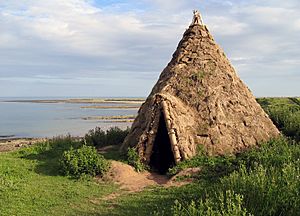Howick house facts for kids
Quick facts for kids Howick house |
|
|---|---|
| Lua error in Module:Location_map at line 420: attempt to index field 'wikibase' (a nil value). | |
| Location | Northumberland, England, UK |
| OS grid reference | NU258178 |
The Howick House is a very old home found in Northumberland, England. It was discovered by chance when an amateur archaeologist noticed ancient flint tools sticking out of a sandy cliff. This amazing find helped experts learn more about how people lived thousands of years ago during the Mesolithic period.
Contents
Discovering the Howick House
What Was Found?
When experts looked closer, they found a circle of big holes where wooden posts once stood. There were also smaller holes and several shallow fireplaces inside the house. These fireplaces had charcoal, burnt nuts, and tiny bone pieces.
How Old Is It?
Scientists used radiocarbon dating on the burnt hazelnut shells found at the site. This showed that the house was built around 7600 BC. People lived in it for about 100 years. Because of its age, it was once called "Britain's oldest house." However, in 2010, an even older structure was found at Star Carr in North Yorkshire.
Life at Howick House
A Permanent Home?
Some of the fireplaces at Howick House showed signs of roasting many nuts. This suggests that a lot of food was cooked there, perhaps to store it for colder times. The strong way the house was built, with big posts, also made experts think it was a permanent home. This was a new idea because people in the Mesolithic period were usually thought to move around a lot.
Why Stay Here?
The idea that people lived here all year round is supported by the area's natural resources. Howick is located near the coast. This meant people had access to many things they needed to survive. They could find animals for hunting, flint for making tools, and wood for building and fires. The sea provided fish, seals, seabirds and their eggs, and shellfish. There was also fresh water nearby.
Many sites from this time are found near the coast. The evidence from Howick, along with findings from Star Carr in Yorkshire, suggests that Mesolithic hunter-gatherers were able to create lasting settlements. This shows they were very skilled at using their environment.


